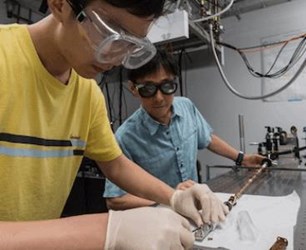Ultrastrong Light-Matter Coupling Could Advance Quantum Computing, Create New States of Matter
By Jof Enriquez,
Follow me on Twitter @jofenriq

Scientists at Rice University have successfully demonstrated in a vacuum cavity experiment one of the strongest light-matter coupling phenomena ever observed.
Experiments of coupling photons and subatomic particles provide insights into cavity quantum electrodynamics and condensed matter physics, and could pave the way for development of quantum computers, among other applications.
However, previous experiments of light-matter coupling have resulted in coupling strengths that are only a small fraction of the photon energy of the light used, as measured by a parameter called vacuum Rabi splitting, thereby limiting their utility.
Rice University researchers now claim to have achieved unprecedented light-matter coupling strengths using a custom-built cavity.
"In our study, vacuum Rabi splitting is as large as 10 percent of the photon energy. That puts us in the so-called ultrastrong coupling regime," said Xinwei Li, a graduate student and co-author of the study published in Nature Physics.
“This is an important regime because, eventually, if the vacuum Rabi splitting becomes larger than the photon energy, the matter goes into a new ground state. That means we can induce a phase transition, which is an important element in condensed matter physics," added Li in a news release.
To achieve this, the team led by physicist Junichiro Kono designed and built a high-quality-factor terahertz cavity with an ultrathin layer of gallium arsenide in a magnetic field to study the interaction of photons and electrons.
The amount of terahertz light inside the optical cavity is actually very weak, according to Kono, but "in a quantum sense, a vacuum is full of fluctuating photons, having so-called zero-point energy. These vacuum photons are actually what we are using to resonantly excite electrons in our cavity."
Qi Zhang, lead author of the study paper, said that tuning the material with a magnetic field resulted "where the light and matter are coupled so strongly that we don’t have light and matter anymore. We have something in between, called a polariton" – a hybrid particle made up of a photon strongly coupled to an electric dipole.
“This general subject is what’s known as cavity quantum electrodynamics (QED),” Kono explained. “In cavity QED, the cavity enhances the light so that matter in the cavity resonantly interacts with the vacuum field. What is unique about solid-state cavity QED is that the light typically interacts with this huge number of electrons, which behave like a single gigantic atom.”
(The relatively new field of cavity QED was pioneered by Serge Haroche and David Wineland who received the 2012 Nobel Prize for Physics for their work.)
“For improving the utility of cavity QED in quantum information, the stronger the light-matter coupling, the better, and it has to use a scalable, solid-state system instead of atomic or molecular systems,” Kono said. “That’s what we’ve achieved here.”
High light-matter coupling strength is a key factor in designing photonic devices, which would use light instead of electricity and thus be faster and use less power than comparable electronic devices.
Further advancements in solid-state cavity QED are expected to find applications in quantum-enabled technologies, such as quantum computers.
